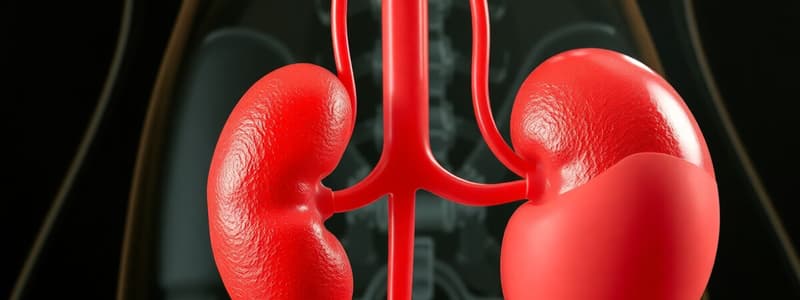Podcast
Questions and Answers
What is the primary function of the excretory system?
What is the primary function of the excretory system?
- To regulate volume and composition of body fluids (correct)
- To produce hormones for growth
- To aid in digestion of food
- To absorb nutrients for energy
Which waste product is NOT a result of the excretion process?
Which waste product is NOT a result of the excretion process?
- Water
- Feces (correct)
- Urea
- Carbon dioxide
Which organ is responsible for filtering out urea and uric acid from the blood?
Which organ is responsible for filtering out urea and uric acid from the blood?
- Bladder
- Kidneys (correct)
- Ureters
- Liver
What structure transports urine from the kidneys to the urinary bladder?
What structure transports urine from the kidneys to the urinary bladder?
What is formed when the liver combines ammonia with carbon dioxide?
What is formed when the liver combines ammonia with carbon dioxide?
What is the primary function of nephrons in the kidneys?
What is the primary function of nephrons in the kidneys?
Which of the following structures is NOT part of a nephron?
Which of the following structures is NOT part of a nephron?
At what volume does the bladder signal the brain for the need to be emptied?
At what volume does the bladder signal the brain for the need to be emptied?
What role does the collecting duct play in the urinary system?
What role does the collecting duct play in the urinary system?
What happens when the bladder volume reaches 600 mL?
What happens when the bladder volume reaches 600 mL?
Which part of the kidney is responsible for filtering the blood?
Which part of the kidney is responsible for filtering the blood?
What structure connects the kidney to the bladder?
What structure connects the kidney to the bladder?
Which of the following statements about Bowman’s capsule is true?
Which of the following statements about Bowman’s capsule is true?
Flashcards
Excretory System Function
Excretory System Function
Regulates body fluid volume and composition, removing waste and reusing needed substances.
Waste Definition
Waste Definition
Substances produced by the body in excess of its needs.
Kidney Location
Kidney Location
Located in the lower back area of the body.
Urea Formation
Urea Formation
Signup and view all the flashcards
Kidney Importance/Function
Kidney Importance/Function
Signup and view all the flashcards
Renal Arteries
Renal Arteries
Signup and view all the flashcards
Urinary Sphincter
Urinary Sphincter
Signup and view all the flashcards
What prompts the urge to urinate?
What prompts the urge to urinate?
Signup and view all the flashcards
Renal Cortex
Renal Cortex
Signup and view all the flashcards
Renal Medulla
Renal Medulla
Signup and view all the flashcards
Renal Pelvis
Renal Pelvis
Signup and view all the flashcards
Nephrons
Nephrons
Signup and view all the flashcards
Bowman's Capsule
Bowman's Capsule
Signup and view all the flashcards
Study Notes
Excretory System Overview
- The excretory system's basic function is to regulate the volume and composition of body fluids. It removes waste and reuses needed substances.
- Waste is any substance produced by the body in excess of its needs.
- Excretion is the process of separating wastes from body fluids and eliminating them.
- Respiratory system excretes CO2.
- Skin excretes water, salts, and urea.
- Digestive system excretes water, salts, and lipids.
- Feces is not a process of excretion.
Organs of the Excretory System
- Kidneys: Located in the lower back, they can function with just one.
- Ureters: Muscular tubes that carry urine from the kidneys to the bladder. Urine is moved through the ureters by peristalsis, a rhythmic muscle contraction. The flow of urine is controlled by a sphincter, a ring of muscle at the base of the bladder.
- Urethra: Tube that carries urine from the bladder out of the body.
Importance of Kidneys
- Body cells break down complex compounds into smaller ones, some of which can be toxic.
- The liver removes the amine group from proteins, forming ammonia.
- The liver combines ammonia with CO2 to form urea.
- Kidneys filter out urea and uric acid from the blood. Urea and uric acid contain ammonia, which is harmful to the body.
Urinary System
- Renal arteries, branches of the aorta, enter the kidneys. "Renal" refers to the kidneys.
- Wastes are filtered from the blood in the kidneys and sent to the bladder via the urethra.
- The urinary sphincter at the base of the bladder releases urine into the urethra when it is time to void.
Bladder Volume
- When the bladder contains 200 mL of urine, it signals the brain to empty.
- 400 mL signals a more urgent need to urinate.
- 600 mL causes involuntary emptying of the bladder.
The Kidney (Internal Anatomy)
- The kidney has three regions: cortex, medulla, and pelvis.
The Kidney (Tissue)
- The kidney's tissue is divided into the outer renal cortex and inner renal medulla.
- Renal pelvis is a hollow chamber that connects the kidney to the ureter.
- Nephrons are microscopic structures within the kidney, embedded in the cortex and medulla, responsible for filtering blood and producing urine.
- Nephrons are organized into a Filter, Tube, and Duct.
Nephron Diagram
- The diagram shows the various components of a nephron. Components include Bowman's Capsule, glomerulus, proximal tubule, loop of Henle, distal tubule, and collecting duct (renal cortex and renal medulla)
Three Regions of Nephron
- Filter: Bowman's capsule and a filtration device (glomerulus) filter fluid from the blood. The filtered fluid, now known as filtrate, enters Bowman's capsule.
- Tube: The filtrate travels through tubules (proximal tubule, loop of Henle, distal tubule) where useful substances are reabsorbed and waste products are secreted.
- Duct: The collecting duct reclaims water and other substances, leaving urine to be excreted.
Studying That Suits You
Use AI to generate personalized quizzes and flashcards to suit your learning preferences.




